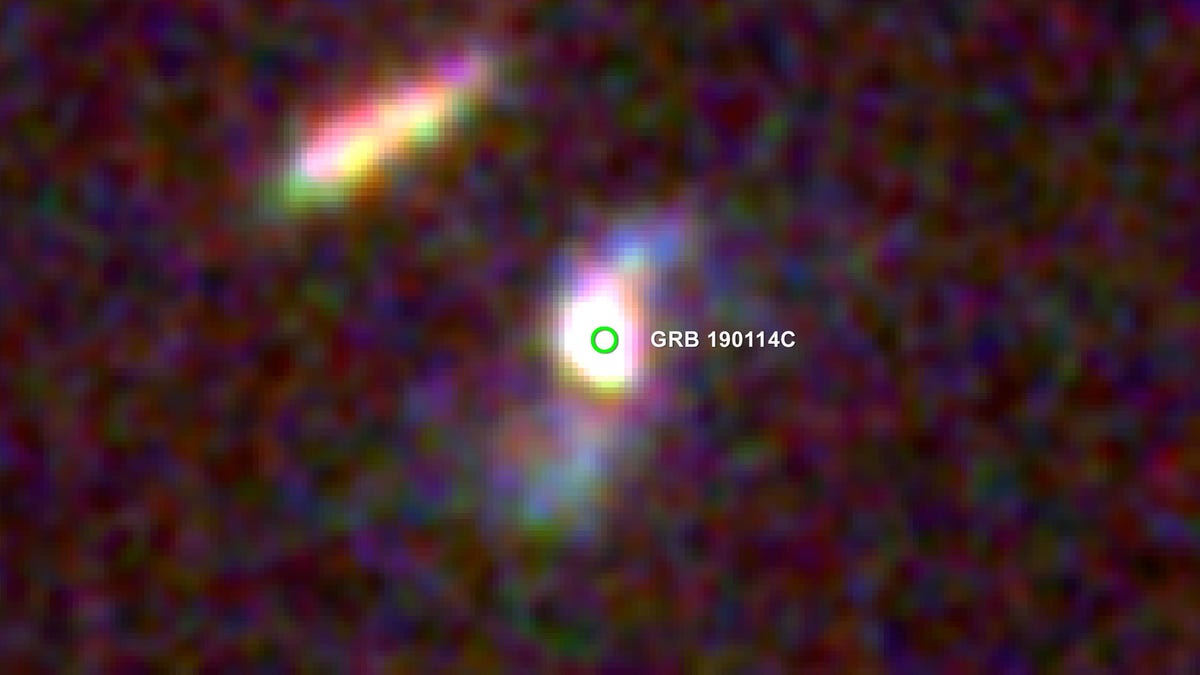Astronomers detect record-setting gamma-ray burst after violent star explosion
A star died to bring you the story of GRB 190114C, a record-setting gamma-ray burst triggered by an epic blast.

The Hubble Space Telescope snapped images of the gamma-ray burst in February and March 2019.
When a massive star, many times bigger than our sun, collapses into a black hole, it releases an almost unfathomable amount of energy. The huge explosions, known as gamma-ray bursts, typically produce the same amount of energy that our sun will over its entire lifetime. Astronomers recently witnessed two GRBs in the distant cosmos emit the highest energy ever seen, opening up a new way of understanding the violent, explosive phenomena.
In a suite of three papers, released in the journal Nature on Nov. 20, a collaboration of international researchers from across the globe report the extreme emission profiles of two bursts: GRB 190114C and GRB 180720B. Typically, GRBs emit low energy rays in the kiloelectronvolt (keV) range, and astronomers have seen them produce bursts below the 100 gigaelectronvolt (GeV) range, but measurements of GRB 190114C are up to 10 times higher, landing between 0.2 and 1 teraelectronvolt (TeV).
The Large Hadron Collider, which accelerates particles and smashes them together, operates at about 13 TeV, accelerating protons at around 6.5 TeV each. A neutron star lurking at the center of the Crab Nebula has been shooting gamma-ray energy at around 450 TeV.
This is the first time TeV gamma-rays have been detected from a gamma-ray burst.
"The theory is that all GRBs produce TeV gamma-rays but our technology is only now advanced enough for us to detect this emission before it fades away," said Gemma Anderson, an astronomer at the International Centre for Radio Astronomy Research and co-author of one of the studies.
GRB 190114C was first picked up by two space-based telescopes, NASA's Neil Gehrels Swift Observatory and the Fermi Gamma-ray Space Telescope, on Jan. 14, 2019. Seconds later, telescopes in Spain under the control of the Major Atmospheric Gamma Imaging Cherenkov collaboration swung around to examine the blast. The MAGIC collaboration pinged researchers around the world to get their eyes on the event, looking at it in a range of different wavelengths -- radio, infrared, optical and X-rays.
"All GRB astronomers around the world were extremely excited as it was the first time something like this had been announced," Anderson said.
Anderson and other researchers in Australia contacted the Australia Telescope Compact Array to monitor the event and the "afterglow," the period of emission after the initial burst. Cooperating with the South African SKA Pathfinder telescope, Anderson and her team examined the low and high radio frequency emissions from GRB 190114C.
Pooling all the data together allowed the spectrum of emissions to be recorded and analyzed. The results helped prove a longstanding theory about the kinds of radiation that are produced in a GRB. In an accompanying Nature piece, Bing Zhang, a physicist at the University of Nevada, called it "a revolutionary discovery."
The teams have continued to monitor the bursts throughout 2019, but Anderson notes that much of the higher-energy light had already faded. "We are only now detecting very low-energy radio light from it, but soon it will have completely faded so that all we can see is the optical and radio light from its host galaxy," she said.
And for Anderson and her team, there are plenty more violent cosmic explosions to look out for.
"Whether all GRBs produce TeV gamma-ray is one of the big science questions that we are now going to explore."
Originally published 5:15 a.m. PT

